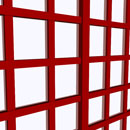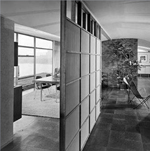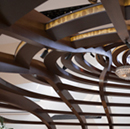Frame | Material
research
In 1933, the German architect Bruno Taut emigrated to Japan, and quickly became enraptured with the country's traditional architecture. He was most impressed with the Katsura Imperial Villa and described it as "Japan's architectural wonder of the world." A year later, Taut published Nippon. Japan Seen through European Eyes in which he devoted two chapters to explaining the universal significance of Katsura. According to historian Manfred Speidel, Taut viewed the 17th century complex "as marvelously embodying and strengthening his own architectural ideas."1
In 1960, architects Walter Gropius and Kenzo Tange contributed essays to the book Katsura: Tradition and Creation in Japanese Architecture. While neither Gropius nor Tange mention Taut, they both reiterate his earlier observations. Gropius emphasizes how the solutions found in Japanese architecture reinforce modernist principles. In one such passage he writes, "The traditional house is so strikingly modern because it contains perfect solutions, already centuries old, for problems which the contemporary Western architect is still wrestling with today; complete flexibility of movable exterior and interior walls, changeability and multi-use of spaces, modular coordination of all the building parts, and prefabrication."2
When Gropius writes of the "complete flexibility of exterior and interior walls" he is referring to shoji which literally means "interceptor panels."3 Made of latticework wooden frames and translucent rice paper, sliding shoji screens form the initial boundary separating exterior gardens from the interior. In Shinto to Ando, Gunter Nitschke identifies three additional adjustable layers beyond the shoji that interact altogether to create "various degrees of permeability" within the transactional space. Nitschke explains, "The en [transactional space] with its various pellucid membranes of different degrees of solidity and porousness separates and/or joins the dwelling with nature."4
At Katsura, Taut remarks on how the materiality and flexibility of shoji contribute to multiple experiences, of comparable splendor. He writes, "The most extraordinary thing to the eyes of the unfamiliar visitor is the silence that reigns in the rooms when the window-doors lined with paper are closed, while when they are open the 'picture' of the garden like a part of the house bursts in on you all at once with an overwhelming effect. The presence of the garden dominates the interior so much that all the surfaces of the walls appear designed to reflect it, and the reflection is especially vivid in the opaque gold and silver of the sliding partitions." Furthermore, Taut appreciates the deliberate simplicity of the lattice work. He commends the discipline of master carpenters, "no less skilled than European cabinet makers" who "never indulged in the tendency to introduce . . . variations in coverings: wood paneling, wood or bamboo grids, etc., as often happened in new luxury residences."5 Thus, by adhering to what Gropius terms an "attitude of restraint", Japanese craftsmen created interiors of "remarkable clarity."6
Devoid of unnecessary ornamentation, the latticework reinforces the proportional system, while simultaneously introducing variety, due to their adjustability. According to Taut, "The Katsura Palace shows despite the stringency in the . . . standards of measurements that the proportions are never applied schematically."7 Gropius notes, "The use of movable partitions and window frames makes the proportions extremely variable." Furthermore, Gropius believes that the spatial order is based on the balancing of "a sequence of patterns in space."8
Gropius corresponded with his contemporaries eager to share his findings in Japan. In 1954, he sent a postcard to Le Corbusier exclaiming, "All what we have been fighting for has its parallel in old Japanese culture."9 Even earlier, the work of Frank Lloyd Wright had demonstrated a Japanese influence. Wright had studied traditional Japanese architecture from books and prints, and he visited the country in 1905. Japanese architecture also inspired architect, Rudolf Schindler. The Schindler/Chace House, completed in 1922, uses sliding wooden screens to create seamless transitions between interior and exterior space. The wooden screens were originally made using canvas, later replaced with glass.10
The genius of traditional Japanese architecture lies in the complementing and reinforcing relationships of a total design. The ordering system, fluid plan, material selection, and careful detailing all contribute to the overall unity of which the shoji is but one component. However, the advent of air conditioning and a greater demand for space has led to reinterpretations of the traditional principles, unfortunately often not for the better. Nitschke laments how Japan's modern version of en is often compressed to a single plane, typically the shoji.11 These translucent screens have become the most appropriated feature of traditional Japanese design, and constantly appear in contemporary interiors all over the world.
Today shoji-inspired screens are often used in office environments to delineate the boundaries of conference rooms. The walls consist of a basic frame, sometimes constructed using metal or wood studs, clad with a translucent material, typically glass or acrylic. Large sliding doors sometimes grant access to the inner space. The clearly articulated framework helps establish an organizing principle, while the translucent cladding gives a greater feeling of openness while still providing the necessary level of privacy. Although less common, some screens omit the translucent cladding material entirely. The open framework divides space but permits almost complete visual access.12
end notes
- 1) Manfred Speidel, "Bruno Taut and the Katsura Villa," Katsura Imperial Villa, ed. Virginia Ponciroli (Milan: Electraarchitecture, 2004), 320, 325.
- 2) Walter Gropius, "Architecture in Japan," Katsura Imperial Villa, 353.
- 3) Gunter Nitschke, From Shinto to Ando: Studies in Architectural Anthropology (Great Britian: Academy Editions, 1993), 86.
- 4) Nitschke, From Shinto to Ando, 87, 90
- 5) Bruno Taut, excerpt from Nippon. Japan Seen through European Eyes in Katsura Imperial Villa, 335.
- 6) Gropius, Katsura Imperial Villa, 355, 376.
- 7) Taut, Katsura Imperial Villa, 335.
- 8) Gropius, Katsura Imperial Villa, 355, 376.
- 9) Francesco Dal Co, "La princesse est modeste" in Katsura Imperial Villa, 389.
- 10) William J.R. Curtis, Modern Architecture Since 1900 (Upper Saddle River, NJ: Prentice Hall, 1996), 233.
- 11) Nitschke, From Shinto to Ando, 90.
- 12) Evidence for the archetypical use and the chronological sequence of Frame as a material was developed from the following sources: 1600 Katsura Imperial Villa [1640] Ehime, Japan in Virginia Ponciroli, ed., Katsura Imperial Villa (Milan: Electra Architecture, 2004), 152 / 1960 Lakewood County Club [1961] Ceil Williams, AID, NSID, Interior Design; Dallas, TX in Anonymous, "Clubs," Interior Design 32, no. 10 (Oct. 1961): 215; PhotoCrd: Anonymous; Oriental Setting Design Show [1967] Lulu Ross, AID of Lulite Associates; Albuquerque, NM in Anonymous, "Three by the AID: New Mexico," Interior Design 38, no. 5 (May 1967): 163; PhotoCrd: Anonymous / 1970 The Bootery [1975] Dennis Jenkins Associates; Miami, FL in Anonymous, The Bootery, Interior Design 46, no. 10 (Sep. 1975): 149; PhotoCrd: Michael Wray / 1980 Levana's Bakery [1981] Rodolfo Imas, Architect/Designer; New York City in Anonymous, "Grand Prize Winner: First Place, Shops, Stores and Showrooms," Interior Design 52, no. 11 (Nov. 1981): 259; PhotoCrd: Norman McGrath; Alusuisse of America Headquarters [1982] Samuel De Santo and Associates; New York City in Anonymous, "Alusuisse of America," Interior Design 53, no. 4 (Apr. 1982): 193; PhotoCrd: Mark Ross; Precision Universal Joint Corporation [1984] Eva Maddox Associates; Chicago, IL in Anonymous, "Break Through," Interior Design 55, no. 7 (July 1984): 227; PhotoCrd: Michael Shields; Vecta Showroom [1988] Morphosis; Los Angeles, CA in Stanley Abercrombie, "Vecta," Interior Design 59, no. 11 (Aug. 1988): 167; PhotoCrd: Tom Bonner / 1990 Caron Cherry Clothing Boutique [1991] Antonio Morello and Donato Savoie, Studio Morsa; Bar Harbor, FL in Justin Henderson, "Raw Refinements," Interiors 150, no. 13 (Aug. 1991): 83; PhotoCrd: Edward Hueber; Hotel Plaza las Fuentes [1991] Pfister Partnership; Pasadena, CA in Beverly Russell, "A New Grand Hotel," Interiors 150, no. 7 (Feb. 1991): 51; PhotoCrd: Jaime Ardiles-Arce; Mackinaw Offices [1992] Mark Randall, AREA Interior Design; New York City in Justin Henderson, "Shoji Subtleties," Interiors 152, no. 4 (Apr. 1992): 55; PhotoCrd: Whitney Cox; Offices, Skowhegan School of Painting and Sculpture [1993] Henry Smith-Miller and Laurie Hawkinson; New York City in Rus Mayer, "Smith-Miller & Hawkinson," Interior Design 64, no. 9 (Sep. 1993): 179; PhotoCrd: Paul Warchol; KPFIA [1994] Kohn Pedersen Fox, Interior Architects; Washington, D.C. in Mayer Rus, "KPFIA," Interior Design 65, no. 5 (Apr. 1994): 133; PhotoCrd: Paul Warchol; Definitions Fitness Center II [1995] Thanhauser & Esterson Architects; New York City in M.J. Madigan, "Fitness Studio," Interiors 154, no. 10 (Oct. 1995): 64; PhotoCrd: Brian Ross; Bumble + Bumble [1996] Anderson/Schwartz; New York City in Henry Urbach, "Shear Energy," Interior Design 67, no. 11 (Sep. 1996): 135; PhotoCrd: Michael Moran; Showroom and Office, Phat Farm [1997] Henry Myerberg and Tucker Viemeister; Smart Design; New York City in Judith Nasatir, "Picket Phences," Interior Design 68, no. 5 (Apr. 1997): 178; PhotoCrd: Peter Mauss, Esto Photography; Marino alla Scala Palazzo, Stores, Showrooms, Offices, Café [1998] Gregotti Associati; Milan, Italy in Edie Cohen, "Trussardi alla Scala," Interior Design 69, no. 5 (Apr. 1998): 178; PhotoCrd: Giuseppe Piermarini; Black Rocket Advertising Agency Offices [1999] Gensler-San Francisco with Zack/DeVito Architecture; San Francisco, CA in Mark Hinshaw, "Rocket Science," Interiors 158, no. 5 (May 1999): 102; PhotoCrd: Sherman Takata / 2000 BMW's Boxer Café [2001] GAD Architects; Istanbul, Turkey in Jen Renzi, "Easy Rider," Interior Design 72, no. 14 (Nov. 2001): 157; PhotoCrd: Thomas Loof, Studio Phi; Matsuri Restaurant [2000] Babey Moulton Jue & Booth Designs; Matsuri, Santiago, Chile in Edie Cohen, "Suchi in Santiago," Interior Design 71, no. 12 (Oct. 2000): 200; PhotoCrd: Oberto Gili; Asia Society Museum Renovation [2002] Voorsanger + Associates; New York City in Laura Fisher Kaiser, "On the Rise," Interior Design 73, no. 5 (May 2002): 228; PhotoCrd: Thomas Loof; Coty Corporation [date] Sidnam Petrone Gartner (SPG); New York City in Oscar Ojeda, Materials: Architecture in Detail (Glocester: Rockport, 2003), 154.
bibliographic citations
1) The Interior Archetypes Research and Teaching Project, Cornell University, www.intypes.cornell.edu (accessed month & date, year).
2) O'Brien, Elizabeth. “Material Archetypes: Contemporary Interior Design and Theory Study.” M.A. Thesis, Cornell University, 2006, 30-41.





